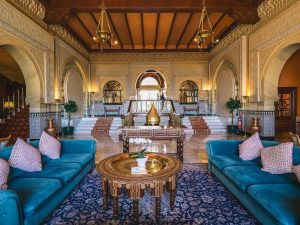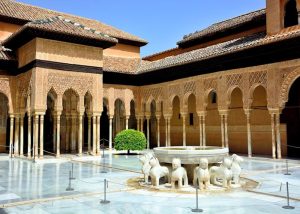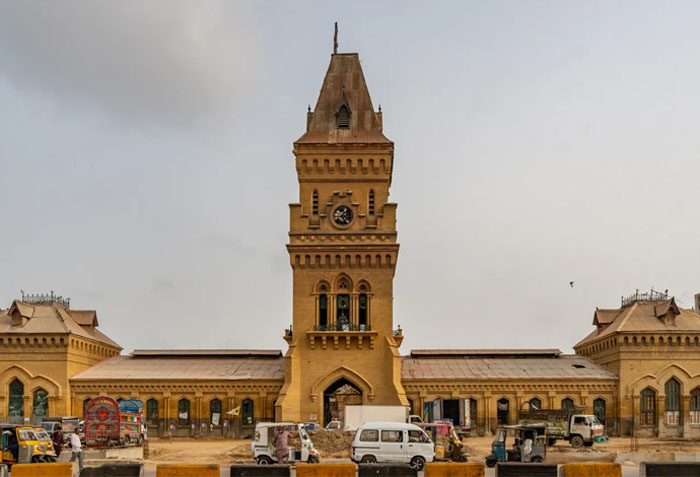Alhambra Palace Introduction
The Alhambra Palace is a marvel of Islamic architecture with its various design layouts, patterns, minarets and domes. The palace masterfully incorporates nature and water into the architecture of the palace. The Alhambra is stretched out over an area of 142,000 square meters and is divided into three parts namely; The Alcazaba, The Nasrid Palaces and The Genera life gardens.
 It revolutionized Islamic architecture in the 13th century by introducing various designs such as; muqarnas, geometric tilework, calligraphy and horseshow arches which has also been adopted in European churches to give it a feeling of grandiosity and divinity. The Alhambra holds significant Islamic history as the last stronghold of the Nasrid dynasty. Built and expanded over centuries, it showcases the height of Islamic art and architecture in Spain and it served as a royal residence, military stronghold, and a symbol of Nasrid power.
It revolutionized Islamic architecture in the 13th century by introducing various designs such as; muqarnas, geometric tilework, calligraphy and horseshow arches which has also been adopted in European churches to give it a feeling of grandiosity and divinity. The Alhambra holds significant Islamic history as the last stronghold of the Nasrid dynasty. Built and expanded over centuries, it showcases the height of Islamic art and architecture in Spain and it served as a royal residence, military stronghold, and a symbol of Nasrid power.
The Alhambra in Granada, Spain, is distinct among medieval palaces for its sophisticated planning, complex decorative programs, and its many enchanting gardens and fountains.
Historical Context
The Nasrid Dynasty was the last Muslim dynasty in Spain. They ruled the Emirate of Granada from 1232 to 1492. The history of the Alhambra is linked to the geographical location. It is located on a rocky hill on the banks of the river Darro. It is protected by mountains and surrounded by forests on all sides.
Alhambra was designed as a military zone at the beginning, it became the royal residence and court of Granada in the mid-13th century after the establishment of the Nasrid Kingdom and the construction of the first palace by the founding king Mohammed ibn Yusuf Ben Nasr, better known as Alhamar. Muhammad ibn Yusuf ibn Nasr secured this region in 1237 and began construction of Alhambra, on Sabika hill the following year. The name Alhambra is derived from the Arabic word ‘al-Qalʻat al-Ḥamrā’ meaning ‘the red fortress’.

The Signature of Islamic Architecture
Islamic architecture is defined by its mastery of geometry, calligraphy, and ornaments. In the Alhambra, stucco designs, tile mosaics (zellij), and wooden muqarnas (stalactite-like decorations) cover walls and ceilings and wide courtyards transform structural elements into art.
The absence of figurative depictions, aligned with Islamic tradition, led craftsmen to elevate abstract forms into spiritual beauty symbolizing the everlasting nature of the creator.
The incorporation of nature and building also symbolizes sustainability in Islamic architecture and showcases the creation of God as being more exceptional than the creation of man. The incorporation of water in the floor and fountains showcase the importance of cleanliness in the religion of Islam and the sound of flowing water, nature and birds give a serene feeling inside the palace.
The Alhambra palace also includes signs of humbleness and imperfection of man. The ceilings of domes in Alhambra comes to signify the vast cosmos and the calligraphy incorporated in the stucco designs comes to signify the divinity and majesty of Allah. The Nasrids did not leave any written record of the names of different rooms, palaces and halls. Many of the names used today like; The Hall of Two Sisters, Hall of the Abencerrages were given by European writers and travelers who visited Alhambra during the eighteenth and nineteenth century.
 How did The Alhambra Master Water?
How did The Alhambra Master Water?
In the Alhambra Palace, water was more than a decoration. The water was sourced from the river Darro and pulled uphill by a waterwheel which could be turned by an animal. The water inside the palace was used for various purposes such as; cultivation, bathing, cooling, heating and time keeping.
The court of the lion in the center of the palace contained a water powered time-keeping device which was built in the fourteenth century. The fountain consisted of 12 lion statues shooting water from their mouths. The time could be determined by counting the number of lion statues which were spouting water at any given time. The fountain was powered by a concealed hydraulic mechanism which was quite revolutionary in the fourteenth century.
Additionally, water was also used for cooling in the summers by producing evaporative cooling and naturally lowering surrounding temperatures. During winters, the water flowed through baths and was heated by underground boilers. The water circulated under the marble floors producing underfloor heating. The steam was also released inside the royal baths providing warmth and relaxation. The steam in the bathhouse was controlled by the windows on the ceilings which could be opened to let the steam out.
Conclusion
The Alhambra palace is a living testament to the Islamic art and heritage. It showcases a way of building and living sustainably and reminds us of an ancient time when Islamic art, poetry, science, philosophy and spirituality was known around the world for its brilliance. Despite changes and damage over the centuries, the Alhambra still continues to shine as Spain’s second most visited monument. It has been recognized as a UNESCO World Heritage site, and is still visited by numerous tourists from all over the world.
References
https://www.alhambra.org/en/alhambra-history.html
The Editors of Encyclopaedia Britannica. “Naṣrid dynasty”. Encyclopedia Britannica, 25 Oct. 2024, https://www.britannica.com/topic/Nasrid-dynasty. Accessed 3 July 2025.
https://www.youtube.com/watch?v=xLaLpMeOyHk&t=50s
Khan Academy. www.khanacademy.org/humanities/ap-art-history/early-europe-and-colonial-americas/ap-art-islamic-world-medieval/a/the-alhambra.
By PNP Intern – Ali Dar
This post has been submitted by one of our interns. PNP Internship Program is an exciting career opportunity for Pakistani university students to get hands-on valuable experience required in national and international job market.
In order to ensure transparency, accuracy and accountability to our readership, please report whenever any error found or need to clarify /correct the post.



